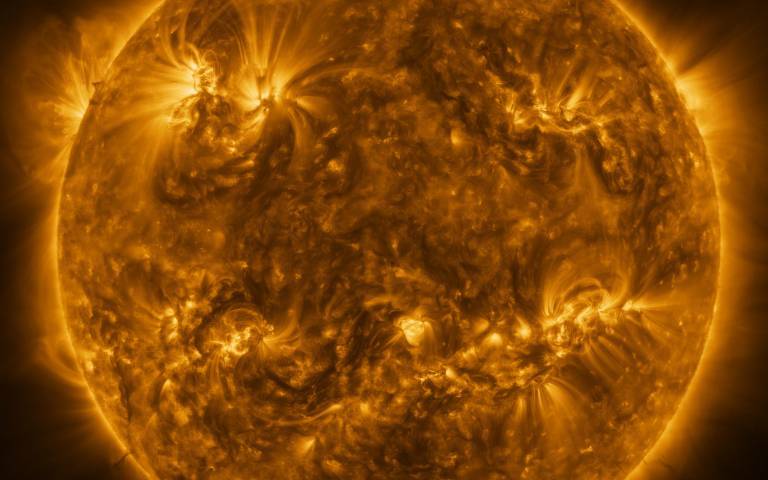Solar snake spotted slithering across Sun’s surface
14 November 2022
The Sun-observing Solar Orbiter spacecraft, which carries instruments proposed, designed and built at UCL, has spotted a “tube” of cooler atmospheric gases snaking its way through the Sun’s magnetic field.

The observation provides an intriguing new addition to the zoo of features revealed by the European Space Agency-led mission, especially since the snake was a precursor to a much larger eruption.
The investigation into the phenomenon is being led by Dr David Long (UCL Mullard Space Science Laboratory), who co-leads the science team for the Extreme Ultraviolet Imager (EUI) onboard the spacecraft.
The snake was seen on 5 September 2022, as Solar Orbiter was approaching the Sun for a close pass that took place on 12 October. It is a tube of cool plasma suspended by magnetic fields in the hotter surrounding plasma of the Sun’s atmosphere.
The plasma in the snake is following a particularly long filament of the Sun’s magnetic field that is reaching from one side of the Sun to another.
Dr Long (UCL Mullard Space Science Laboratory) said: “You're getting plasma flowing from one side to the other but the magnetic field is really twisted. So you're getting this change in direction because we're looking down on a twisted structure.”
The movie has been constructed as a time-lapse from images from the EUI suite of instruments. In reality, the snake took around three hours to complete its journey but at the distances involved in crossing the solar surface that means the plasma must have been travelling at around 170 km per second.
What makes the snake so intriguing is that it began from a solar active region that later erupted, ejecting billions of tonnes of plasma into space. This raises the possibility that the snake was a sort of precursor to this event – and Solar Orbiter caught it all in numerous instruments. Dr Long said: “It's a really nice combination of datasets that we only get from Solar Orbiter.”
For the spacecraft’s Energetic Particle Detector (EPD), the eruption was one of the most intense solar energetic particles events detected so far by the instrument.
More intriguing still is that the plasma from this eruption, known as a coronal mass ejection, happened to sweep over NASA’s Parker Solar Probe, allowing its instruments to measure the contents of the eruption.
Being able to see an eruption take place and then sample the ejected gasses, either with its own instruments or those of another spacecraft, is one of Solar Orbiter’s principal scientific aims. It will allow a better understanding to be developed of solar activity and the way it creates ‘space weather’, which can disrupt satellites and other technology on Earth.
Solar Orbiter is a space mission of international collaboration between ESA and NASA, operated by ESA. It launched on 10 February 2020, and earlier this month celebrated its 1,000th day in space.
Links
- Dr David Long’s academic profile
- UCL Mullard Space Science Laboratory
- UCL Mathematical & Physical Sciences
- ESA-led Solar Orbiter mission
Source
Movie
- Credit: ESA & NASA/Solar Orbiter/EUI Team; acknowledgement: Frédéric Auchère, IAS
Image
- An earlier image of the Sun as seen by Solar Orbiter in extreme ultraviolet light from a distance of roughly 75 million kilometres. In total, the final image contains more than 83 million pixels in a 9148 x 9112 pixel grid, making it the highest resolution image of the Sun’s full disc and outer atmosphere, the corona, ever taken. Credit: ESA & NASA/Solar Orbiter/EUI team; Data processing: E. Kraaikamp (ROB).
Media contact
Mark Greaves
T: +44 (0)7990 675947
E: m.greaves [at] ucl.ac.uk
 Close
Close

